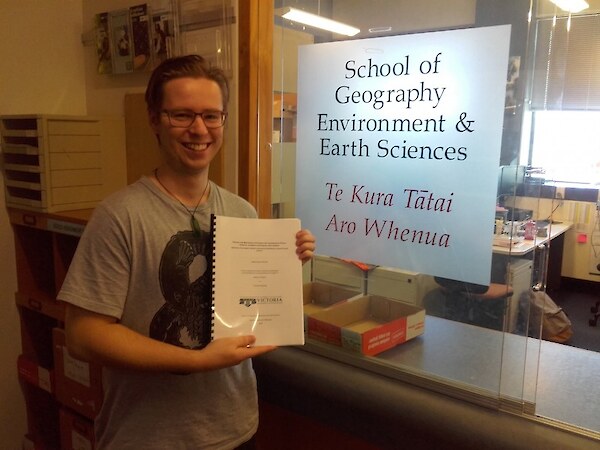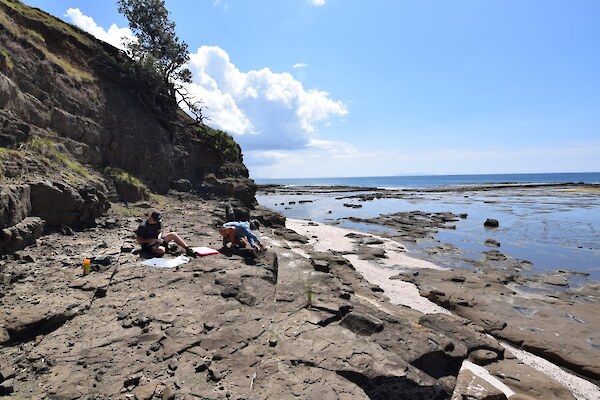2017 Scholarship recipient completes study
Ba ck in March, just a few days before the Coastal Restoration Trust conference, Aidan McLean submitted his Masters thesis, after much hard work, some set backs and no small amount of lost sleep. The project was the culmination of a lot of support from a lot of different people. The Coastal Restoration Trust was a big part of this, with the financial contribution from the graduate research scholarship. This research project was very successful and the results will be written up for submission to the Journal Geology.
ck in March, just a few days before the Coastal Restoration Trust conference, Aidan McLean submitted his Masters thesis, after much hard work, some set backs and no small amount of lost sleep. The project was the culmination of a lot of support from a lot of different people. The Coastal Restoration Trust was a big part of this, with the financial contribution from the graduate research scholarship. This research project was very successful and the results will be written up for submission to the Journal Geology.
This thesis, titled: Histories and Mechanisms of Change in the Development of Shore Platforms at Kaikōura and Rodney, New Zealand: Application of Cosmogenic Nuclides and Numerical Modelling on Exposed Coastal Surfaces, is summarised in brief below.
Global sea level rise is contributing to the acceleration of cliff erosion rates in New Zealand, where it surpasses rates of uplift. A significant challenge facing scientists and managers is that we have no reliable method for determining past rates of coastal erosion along harder rock cliffs, over the time-scales that significant sea level change occurs (100s-1000s of years). This gap in knowledge is limiting efforts to model and understand the relationship between sea level rise and cliff erosion rates.
 A methodology called Cosmogenic Beryllium-10 analysis (similar to the better-known method of radio-carbon dating) has been applied on two low angle shore platforms in New Zealand to determine the timing and speed of sea cliff erosion during the last 10,000 years. Work was conducted on a tectonically active platform at Kaikoura, Canterbury and an inactive platform at Cape Rodney, Auckland. This is the first application of this method to a shore platform study in New Zealand and adds two new data-sets to the very small group of global shore platform chronologies.
A methodology called Cosmogenic Beryllium-10 analysis (similar to the better-known method of radio-carbon dating) has been applied on two low angle shore platforms in New Zealand to determine the timing and speed of sea cliff erosion during the last 10,000 years. Work was conducted on a tectonically active platform at Kaikoura, Canterbury and an inactive platform at Cape Rodney, Auckland. This is the first application of this method to a shore platform study in New Zealand and adds two new data-sets to the very small group of global shore platform chronologies.
The analysis shows New Zealand shore platforms are young, having developed over the last few thousand years. Long-term platform surface erosion rates at Kaikoura (<0.2mm/year) were found to be significantly slower than modern erosion rates (>0.4mm/year), potentially due to uplift from earthquakes, driving up weathering rates on the tidally inundated platform due to their effect on sea level. The results at Okakari Point, Rodney, reveal a significant role of recent sea level fall after ~4000yrs before present, driving surface denudation (0.1mm/year). The long-term cliff erosion rate at Okakari point was found to be 24.66mm/year. Patterns in cosmogenic nuclide concentrations in New Zealand’s shallow platforms differ from global examples recorded on steeper platforms. Exploratory numerical modelling was applied with the coupled Rocky Profile CRN model to identify process relationships between key drivers within platform coastal systems and scenarios of sea level change and active tectonics.
This combined geochemical and numerical modelling study has shown that shore platforms in New Zealand have complex histories, with different potential driving forces at Kaikoura and Okakari. This highlights the local variability in platform development and cliff retreat, suggesting that estimates of future shoreline erosion will need to take local contingencies into account.
Posted: 27 April 2018 in the News category
